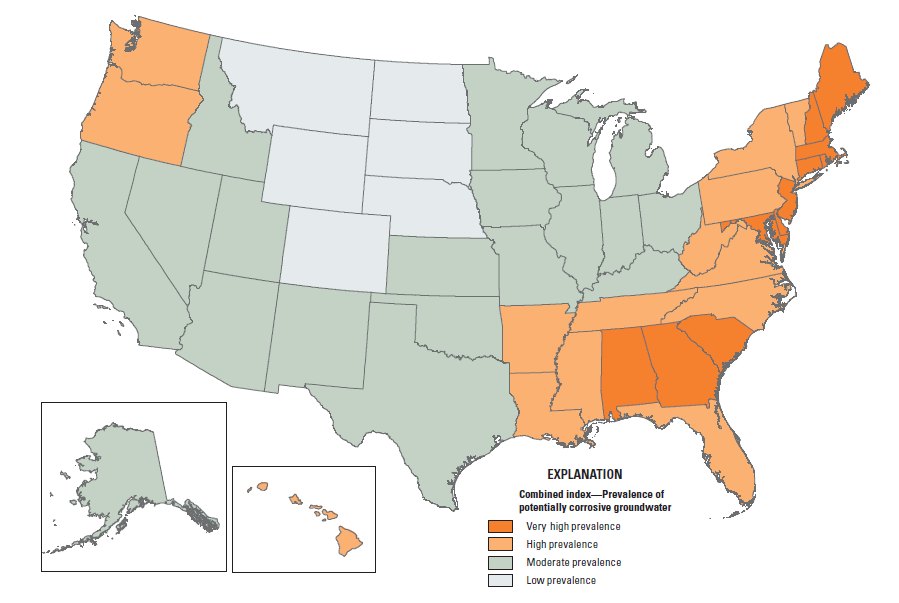
Private well owners are responsible for all water quality sampling before and after the well is approved. Please keep the following in mind when determining whether you should test your private well water supply for lead.
SOURCES OF LEAD IN PRIVATE WELL WATER
Both the United States Geologic Survey and the National Groundwater Association report that the natural presence of lead in groundwater tends to be very small and generally non-detectable. Lead can enter groundwater from industry, mining, plumbing, gasoline, coal, and as a water additive. A greater concern, however, is the presence of lead in plumbing fixtures or well components, and certain solder used to connect pipes and joints.
CLICK For Potential sources of lead in plumbing and wells:
• lead pipes or fittings used in homes built prior to 1930
• lead solder used in copper fittings in homes built prior to the late 1980s
• “lead-free” brass components, which, in all states, except California, may have contained up to 8 percent lead, prior to 2014
• galvanized steel that contained 0.5 to 1.4 percent lead, prior to 2014
POTENTIALLY CORROSIVE GROUNDWATER IN VIRGINIA

CLICK for Map Explanation - Groundwater Corrosivity and Lead in Plumbing Systems
The 2016 USGS report “Assessing the Potential Corrosivity of U.S. Groundwater”, identifies Virginia as having a “high prevalence” of potentially corrosive groundwater (based on a study of 20,000 wells nationwide). Per the report, “(n)aturally corrosive water is not dangerous to consume by itself, however it can cause health-related problems by reacting with pipes and plumbing fixtures in homes. If plumbing materials contain lead or copper, these metals may be leached into the water supply by corrosive water. Signs of corrosive water causing leaching of metals may include bluish-green stains in sinks, metallic taste to water, and small leaks in plumbing fixtures.”
In other words, it is the combination of corrosive groundwater and lead in the plumbing system that carries the highest risk of lead in a private well system.
LEAD AND YOUR HEALTH

The Safe Drinking Water Act requires EPA to determine the level of contaminants in drinking water at which no adverse health effects are likely to occur with an adequate margin of safety. These non-enforceable health goals, based solely on possible health risks, are called maximum contaminant level goals (MCLGs). EPA has set the maximum contaminant level goal for lead in drinking water at zero because lead is a toxic metal that can be harmful to human health even at low exposure levels. Lead is persistent, and it can bioaccumulate in the body over time.
Young children, infants, and fetuses are particularly vulnerable to lead because the physical and behavioral effects of lead occur at lower exposure levels in children than in adults. A dose of lead that would have little effect on an adult can have a significant effect on a child. In children, low levels of exposure have been linked to damage to the central and peripheral nervous system, learning disabilities, shorter stature, impaired hearing, and impaired formation and function of blood cells.
The Centers for Disease Control and Prevention (CDC) recommends that public health actions be initiated when the level of lead in a child’s blood is 5 micrograms per deciliter (µg/dL) or more.
It is important to recognize all the ways a child can be exposed to lead. Children are exposed to lead in paint, dust, soil, air, and food, as well as drinking water. If the level of lead in a child’s blood is at or above the CDC action level of 5 micrograms per deciliter, it may be due to lead exposures from a combination of sources. EPA estimates that drinking water can make up 20 percent or more of a person’s total exposure to lead. Infants who consume mostly mixed formula can receive 40 percent to 60 percent of their exposure to lead from drinking water.
CLICK for Information on Specific Health Risks
Even low levels of lead in the blood of children can result in:
• Behavior and learning problems
• Lower IQ and hyperactivity
• Slowed growth
• Hearing problems
• Anemia
In rare cases, ingestion of lead can cause seizures, coma and even death.
Lead can accumulate in our bodies over time, where it is stored in bones along with calcium. During pregnancy, lead is released from bones as maternal calcium and is used to help form the bones of the fetus. This is particularly true if a woman does not have enough dietary calcium. Lead can also cross the placental barrier exposing the fetus to lead. This can result in serious effects to the mother and her developing fetus, including:
• Reduced growth of the fetus
• Premature birth
Lead can also be transmitted through breast milk.
Lead is also harmful to adults. Adults exposed to lead can suffer from:
• Cardiovascular effects, increased blood pressure and incidence of hypertension
• Decreased kidney function
Source: US EPA
LEAD IN WELL – WHAT CAN I DO?
First, try to determine the source of the lead in your water. If the groundwater coming into the well is not the problem, a water well system contractor can inspect your well system for any components that contain higher lead levels. A plumber may be able to help in identifying the sources of lead in the household plumbing.
If household plumbing or well system components are the source of unsafe levels of lead, the home owner has options:
CLICK for Options
• Replace the problem components with new components that meet current federal requirements.
• Treat water that is being consumed with appropriate treatment technologies. The National Sanitation Foundation recommends the following:
“Potential treatment options for lead can include filters, reverse osmosis units, and distillers. Make sure the system is certified under NSF/ANSI standards for lead reduction, which means that the system has been independently verified to be able to reduce lead from 0.150 mg/L to 0.010 mg/L or less.
“If you have a private well and have high lead levels, the problem could be due to low pH. When pH levels drop below 7.0, water becomes acidic which can cause lead to leach from plumbing fixtures. Acid neutralizing systems are generally used to correct this situation. By adding a chemical like soda ash to the water to boost pH above 7.0, the system can help reduce both lead and copper leaching attributable to low pH.
“If you do choose to use a water treatment system, remember that most water treatment systems have replaceable components or require regular service, so be sure to follow the manufacturer’s maintenance instructions and replace filters at the recommended interval.”
• Flush water that has been sitting in your water system for a long time (such as overnight) to remove water into which lead has leached. You may need to take several water samples from different taps to determine how to effectively flush your system for the purpose of lead reduction in drinking water. Water that is being flushed can be used for purposes that do not involve ingestion.
The preceding options vary in cost and ease of implementation, so that what works best for one well owner may not have the same advantages for another.
Source: National Groundwater Association
LINKS
VDH Office of Drinking Water/ Lead in Drinking Water
National Groundwater Association
Virginia Household Water Quality Program – LEAD
Center for Disease Control: Lead in Drinking Water from Private Wells
